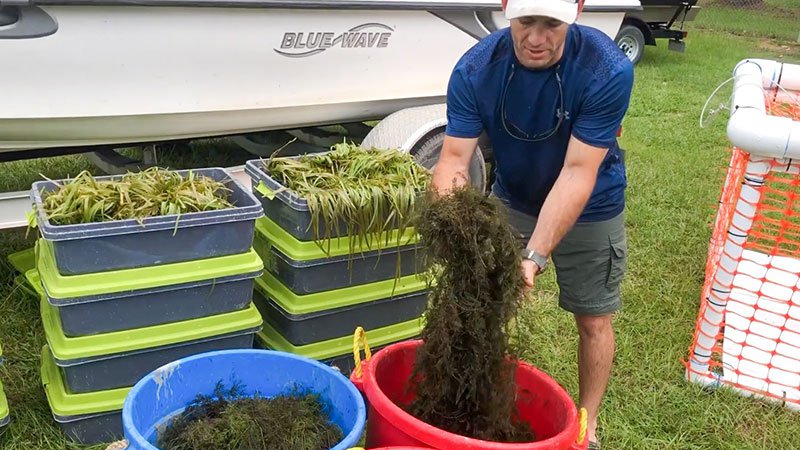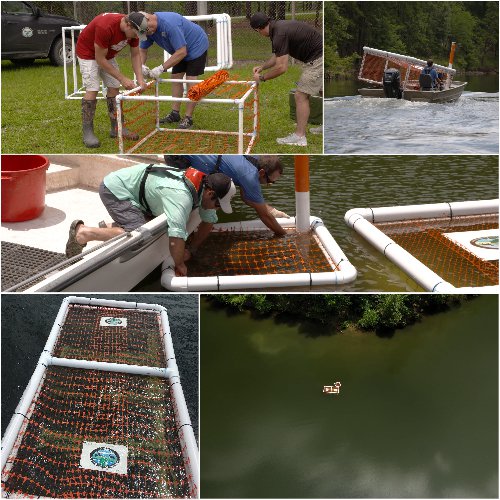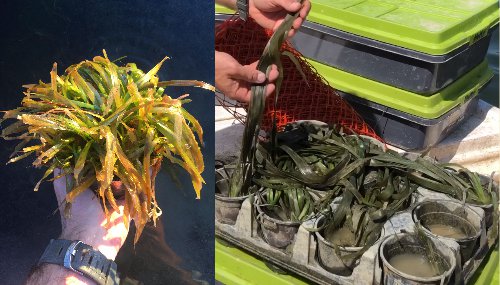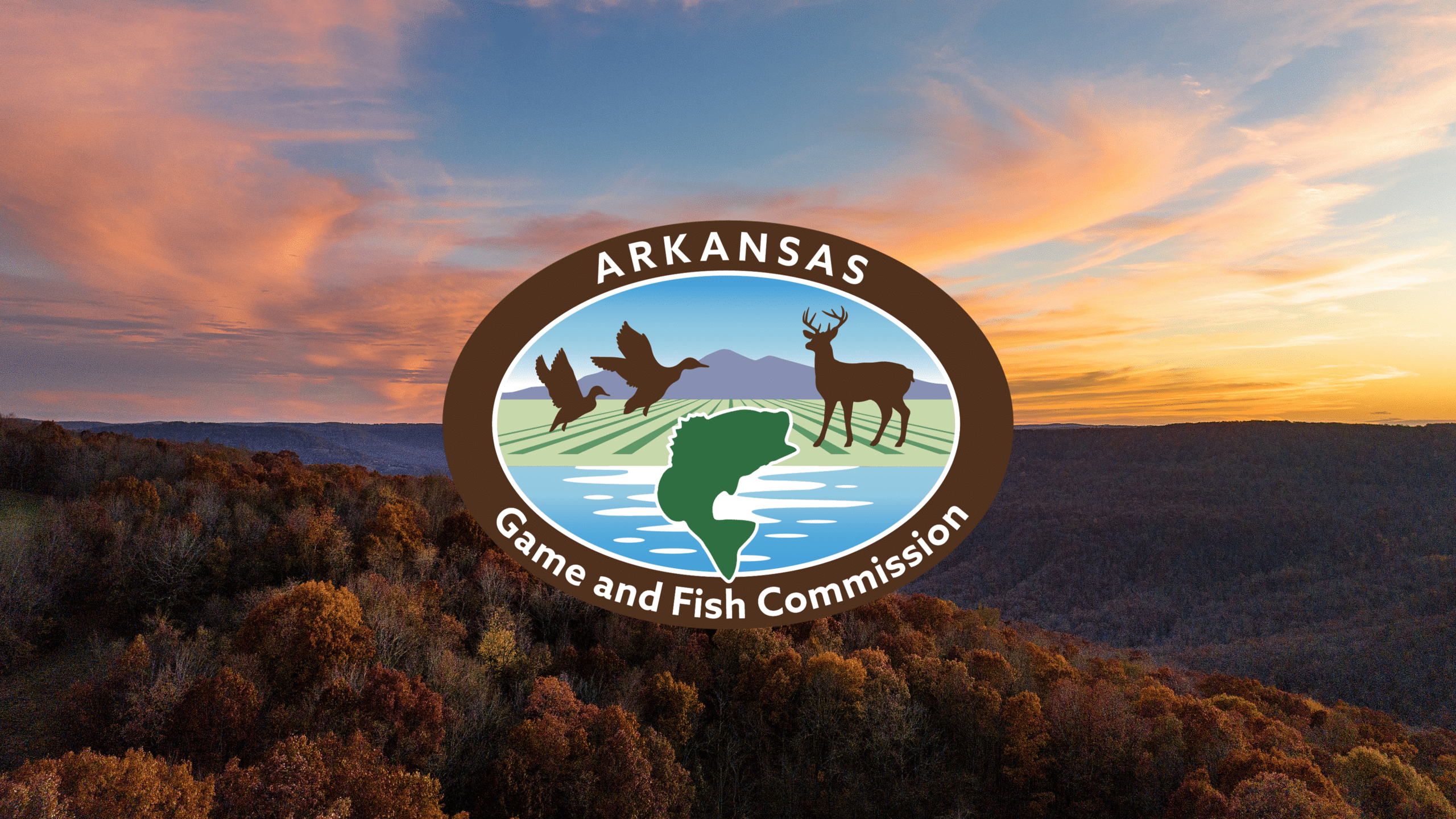Water gardens gaining ground on Arkansas fisheries
ON 08-19-2020

Aug. 19, 2020
Randy Zellers
Assistant Chief of Communications

ARKADELPHIA — When Sean Lusk graduated from Auburn University with a master’s degree in fisheries management, he never dreamed his future would include taking up water gardening in Arkansas, but during the last two years he and other biologists have been hard at work planting, potting and growing aquatic vegetation in an effort to restore the once vibrant fishery at DeGray Lake.
DeGray was once known for thick beds of aquatic vegetation, which included non-native species such as hydrilla and Brazilian elodea that grew to as deep as 20 feet in some places and caused issues with boating and other recreation. In 2008 and 2009, extremely low water throughout winter exposed the root systems of this vegetation, killing much of it. Spring rain in each of those years then flooded the system quickly, placing what vegetation remained under many feet of muddy water with very little sunlight penetration, snuffing it out.
Lusk, a fisheries management biologist at the Hot Springs Regional Office and avid angler, says AGFC staff have put hundreds of hours into trying to get aquatic grasses back into DeGray to improve available habitat for bass, crappie and other sport fish. Their latest attempt includes some innovative floating enclosures to give plants a jump-start.
“The AGFC has worked with the [U.S. Army] Corps of Engineers for years to reestablish beneficial aquatic vegetation and add other forms of cover to the lake when we could,” Lusk said. “But getting native vegetation to come back has been a big challenge.”
Two major obstacles have stood in the way: extreme water level fluctuation in the flood-control reservoir and predation of the aquatic grasses by turtles and other wildlife before it can become established.
“We consulted with Lynde Dodd, a habitat restoration specialist with the Corps’ Engineering, Research and Development Center, last June, and she began developing a road map on options to move forward,” Lusk said. “Cages were needed to protect the vegetation from herbivory until enough became established. Those cages needed to rise up and down with the water level, but still allow seeds and fragments from the plants to disperse into the lake.”
AGFC biologists are focusing their efforts on four native plants, some of which were present at DeGray before the die-off.

“The four species of plants we’re working with are eelgrass, American pondweed, Sago pondweed and coontail,” Lusk said. “They offer a variety of benefits to fish in different depth ranges, and they are tolerant to low-light conditions if we have muddy water come through the reservoir. We’re growing the plants in greenhouses owned by the Corps and renovated to establish aquatic vegetation.”
The planting team includes Lusk, AGFC Fisheries Supervisor Brett Hobbs, AGFC Black Bass Program Biologist Jeff Buckingham, and Samuel Scott and Levi Rengstorf, regional fisheries staff at the AGFC’s Hot Springs office. Together they have spent many days during the summer collecting, planting, repotting and transplanting the aquatic grasses into the special floating cages throughout the lake.
“Scott Jones and Jonathan Spurgeon at the University of Arkansas at Pine Bluff worked with us to determine the areas of the lake that had the most potential to benefit the lake if the vegetation began to reproduce,” Lusk said. “We don’t want the entire lake to be full of vegetation, because too much is just as bad as not enough, so we want to concentrate our efforts on areas that have the best benefit.”
Cages are constructed of PVC and plastic construction fencing. They are anchored in place much like floating docks, where they may float freely in the water column and adjust to any fluctuations. Biologists altered the designs to fit the needs of particular plants being used in each cage.
“Coontail does just fine as a free-floating grass, so we have it in cubes that are open on all sides,” Lusk said. “But eelgrass and pondweeds need to be rooted, so we developed cages that had rigid bottoms that support potted plants.”
Lusk says the aquatic cages and nurseries have come with a large learning curve. Biologists already have made changes to their original designs based on results from the first year of the project.
“The coontail would grow so thick that it actually started shading itself out,” Lusk said. “We’ve learned that we’re better off to have more cages of coontail that are smaller than to have a few larger cages. We’re also learning just how devastating aquatic turtles can be on some vegetation. Some small turtles were able to fit through the gaps in the snow fencing of one enclosure that had a foot-tall pondweed in it. After a short time in the enclosure,the turtles had completely stripped the vegetation clean. It was like scorched earth on the water. We’ve since added additional layers of smaller-sized mesh to help keep them out.”
Once the vegetation takes hold, biologists hope it is able to outproduce what turtles and other wildlife eat; it’s just a matter of getting it established.
“We know from history that the lake was full of vegetation with these predators around and we know these areas are productive, we just need to get the seed in the right place at the right time,” Lusk said.
The effects of the project will be evaluated in the next year, once again calling on the assistance of Jones and Spurgeon at UAPB.
“If we can get some reproduction, this will be huge, you just can’t understate the value of aquatic vegetation to a fishery,” Lusk said. “When we’re transplanting these plants, they’re just full of insects and crustaceans that will provide food for growing fish, and the cover provided by the vegetation will help young fish survive. It also gives predators a place to ambush prey much more efficiently and exhibit better growth rates.”
Even though a formal evaluation is still to come, biologists have seen enough promise in the technique that it is being applied to other bodies of water in Arkansas. Similar cages have been placed at Greers Ferry and Greeson lakes to try to get plants established in those fisheries, both of which have a history of having difficulty establishing native aquatic vegetation.
“It’s exciting to see the technique being shared in other lakes,” Lusk said. “It’s hard work and we’re constantly learning how to improve our process, but aquatic vegetation is that much of a game-changer that it’s worth the effort for our anglers. We’ve even come across some anglers who said they didn’t really like fishing in vegetation, but the benefit of the grass is for the fish, which ends up being a benefit to them in the long term as well.”
Visit the Arkansas Game and Fish Commission’s AGFC Black Bass Management Facebook Page for updates on the DeGray Vegetation Project and many other efforts AGFC biologists are undertaking to improve the quality of angling in The Natural State.
Recent News

AGFC Commissioner Meeting Notice
Jul. 15, 2025

Arkansas Wildlife Weekly Fishing Report
Jul. 10, 2025
Subscribe to Our Weekly Newsletter E-mails
Don’t miss another issue. Sign up now to receive the AGFC Wildlife Weekly Newsletter in your mailbox every Wednesday afternoon (Waterfowl Reports are published weekly during waterfowl season and periodically outside the season). Fishing Reports arrive on Thursdays. Fill in the following fields and hit submit. Thanks, and welcome!
